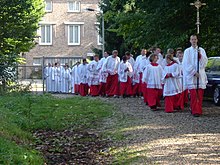Female altar servers
The evolution of the ministry of altar servers has a long history. In the early Church, many ministries were held by men and women. By the early Middle Ages, some of these ministries were formalized under the term "minor orders" and (along with the diaconate) used as steps to priestly ordination. One of the minor orders was the office of acolyte.

In several Christian Churches women have traditionally been excluded from approaching the altar during the liturgy. Thus The Service Book of the Orthodox Church (English translation by Isabel Florence Hapgood) states that "no woman may enter the Sanctuary at any time".[1] In the Roman Rite of the Catholic Church the traditional rule was: "women may not enter [the sanctuary] at all".[2]
This did not exclude women, especially in convents of nuns, entering the altar area at other times, as for cleaning.
In Eastern Churches women are further restricted by not being allowed inside the altar area and in some traditions even within the church building during their monthly periods.[3] The Latin Church abandoned this practice in 735.[4]
Traditional practice in the Catholic Church
Formerly, it was generally forbidden to have women serving near the altar within the sacred chancel (infra cancellos), that is, they were prohibited from entering the altar area behind the altar rails during the liturgy. In convents of nuns, women did serve within the chancel.[5]
In his encyclical Allatae sunt of 26 July 1775, Pope Benedict XIV renewed the prohibition, "Women should not dare to serve at the altar; they should be altogether refused this ministry", stated more than five centuries earlier by Pope Innocent IV in his letter Sub catholicae professione of 6 March 1254 to Odo of Tusculum on Greek rites.[6] Pope Benedict XIV also stated that what he called the evil practice of women serving the priest at the celebration of Mass had been condemned also by Pope Gelasius I (492−496).[7]
He used the following words:
Pope Gelasius in his ninth letter (chap. 26) to the bishops of Lucania condemned the evil practice which had been introduced of women serving the priest at the celebration of Mass. Since this abuse had spread to the Greeks, Innocent IV strictly forbade it in his letter to the bishop of Tusculum: "Women should not dare to serve at the altar; they should be altogether refused this ministry." We too have forbidden this practice in the same words in Our oft-repeated constitution Etsi Pastoralis, sect. 6, no. 21.[8]
The references to "the Greeks" pertains to the Orthodox practice of ordaining women as deacons. With the practice of private Masses (Mass by a priest and one other person, often offered for a deceased person), scandal was an additional reason not to have a woman or girl alone with a priest. However, it has been customary in convents of women for nuns to perform the ministry of acolyte without being formally ordained to that minor order. This practice was used when the Council of Trent developed the seminary system where men in minor orders would go away to schools for training to be a priest rather than study under a parish priest.[9]
After the 1963 decision of the Second Vatican Council to reform the Catholic liturgy,[10] trials were carried out, including that of allowing females to serve Mass in girls' schools and convents. However, the 1970 instruction Liturgicae instaurationes, in putting the council's decree into effect, withdrew permissions granted for experiments with the Mass while the reform was a work in progress[11] and reaffirmed the traditional rules reserving service of the celebrant at the altar to males alone.[12] This was repeated more briefly in the 1980 instruction Inaestimabile donum: "Women are not, however, permitted to act as altar servers." [13] At the time of 1970 and 1980 instructions, the 1917 Code of Canon Law was still in force. It ruled: "A woman is not to be the server at Mass except when a man is unavailable and for a just reason and provided that she give the responses from a distance and in no way approach the altar."[14] It was superseded by the 1983 Code of Canon Law, which did not maintain the prohibition.
Change in 1983
The 1983 Code of Canon Law altered the juridical situation. Without distinguishing between male and female, it declared: "Lay persons can fulfill the function of lector in liturgical actions by temporary designation. All lay persons can also perform the functions of commentator or cantor, or other functions, according to the norm of law."[15]
With the promulgation of the 1983 Code of Canon Law, prominent canonists argued that this reservation to males no longer held,[16] based on the inclusion of both males and females in canon 230 §2: "Lay persons can fulfill the function of lector in liturgical actions by temporary designation. All lay persons can also perform the functions of commentator or cantor, or other functions, according to the norm of law." In many dioceses, females were allowed to act as altar servers without explicit clarification on the matter from the Holy See.
On 30 June 1992, the Pontifical Council for the Interpretation of Legislative Texts issued an authentic interpretation of that canon declaring that service of the altar is one the "other functions" open to lay persons in general.[17]
This 1992 authentic interpretation (confirmed by Pope John Paul II on 11 July 1992), declaring that service at the altar is one of the liturgical functions that can be performed by both lay men and women, was recalled in a circular letter[18] that each diocesan bishop can decide whether to allow them in his diocese..[19]
A later document, from 2001, states that, even if a bishop permits female altar servers, the priest in charge of a church in that diocese is not obliged to recruit them, since nobody has a right to become an altar server. The document also states that "it will always be very appropriate to follow the noble tradition of having boys serve at the altar".[20]
Pope Benedict XVI had both male and female altar servers in Papal masses in London (2010), Berlin, and Freiburg (2011).

United States
In the United States the Diocese of Lincoln, Nebraska was the only diocese that does not allow females to be altar servers,[21] after the only other diocese ended its prohibition on female altar servers in 2006.[22] The cathedral of the Diocese of Phoenix announced in August 2011 that it would become another of the Catholic churches in which girls would not be allowed to serve at the altar.[23]
Archbishop Raymond Leo Burke has been publicly critical to the introduction of female altar servers as part of what he calls "radical feminism" and a unwelcome sign of the "feminization" of the Church.[24] Burke says that it requires a "certain manly discipline to serve as an altar boy in service at the side of a priest, and most priests have their first deep experiences of the liturgy as altar boys. If we are not training young men as altar boys, giving them an experience of serving God in the liturgy, we should not be surprised that vocations have fallen dramatically."[25]
References
- "Service Book of the Orthodox Church, The (Hapgood)". SVS Press & Bookstore. Retrieved 2020-01-26.
- Fortescue, Adrian; O'Connell, J. B.; Reid, Alcuin (2009-03-29). The Ceremonies of the Roman Rite Described. A&C Black. ISBN 978-0-86012-462-7.
- Alessandro Bausi, Languages and Cultures of Eastern Christianity: Ethiopian (Routledge 2017)
- Karl Kaser, The Balkans and the Near East: Introduction to a Shared History (LIT Verlag 2011), p. 250
- Catholic Moral Theology, Fr. Jone OFMCap, Nr. 315.
- Mulieres autem servire ad altare non audeant, sed ab illius ministerio repellantur omnino
- Encyclical Allatae sunt of 26 July 1775, section 29
- "Allatae Sunt".
- XXIII Session, Council of Trent, ch. XVIII. Retrieved from J. Waterworth, ed. (1848). The Canons and Decrees of the Sacred and Oecumenical Council of Trent. London: Dolman. pp. 170–92. Retrieved June 16, 2009.
- See Sacrosanctum concilium
- Liturgicae instaurationes, 12.
- "In conformity with norms traditional in the Church, women (single, married, religious), whether in churches, homes, convents, schools, or institutions for women, are barred from serving the priest at the altar", Liturgicae instaurationes, 7.
- Inaestimabile donum, 18
- "CIC 1917: text - IntraText CT". www.intratext.com. Retrieved 2020-01-26.
- "Code of Canon Law - IntraText". www.vatican.va. Retrieved 2020-01-26.
- The Code of Canon Law: A Text and Commentary, ed. by James A. Coriden, Thomas J. Green, and Donald E. Heintschel, Paulist Press, 1985, ISBN 0-8091-0345-1.
- "Can. 230, § 2". www.delegumtextibus.va. Retrieved 2020-01-26.
- Acta Apostolicae Sedis 86 (1994) pp. 541-542 (Official Latin; English translation)
- Vatican Communication on Female Altar Servers
- "The Catholic Liturgical Library".
- "USATODAY.com - Neb. diocese is lone U.S. holdout on allowing altar girls".
- "Neb. diocese is lone U.S. holdout on allowing altar girls". USA Today. 22 March 2006. Archived from the original on 9 November 2017. Retrieved 2 November 2018.
- Clancy, Michael. "Phoenix diocese cathedral won't allow girl altar servers". The Arizona Republic. The Arizona Republic. Archived from the original on 2 November 2018. Retrieved 2 November 2018.
- McGough, Michael, "Opinion Cardinal Burke: Serving at Mass is a 'manly' job" Archived 2015-01-11 at the Wayback Machine, LA Times, January 9, 2015.
- margeryeagan, "The Church has a problem with women? Really?" Archived 2016-10-02 at the Wayback Machine, Crux, January 8, 2015.